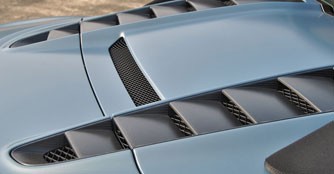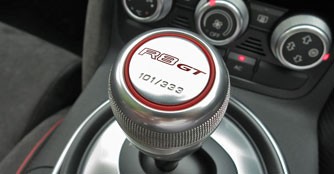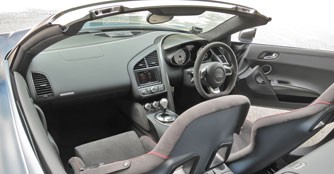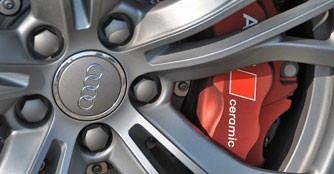Audi R8 GT Spyder 5.2 FSI (A) Review
12 Sep 2012|14,073 views
When the R8 LMS GT3 race car was first unveiled way back in 2009, rumours were abuzz that Audi will introduce a hardcore, lighter version of the R8 V10 in time to come. This model finally became a reality last year with the debut of the 560bhp LMS-inspired R8 GT.
With a limited production run of just 333 cars, it wasn't long before the GT was sold out. Don’t fret though - those that have missed the GT coupe will be glad to know that Audi has introduced a drop-top Spyder version of the GT, the GT Spyder. Just like the GT coupe, the GT Spyder will also be a limited production model with a 333 production run for all worldwide markets, will only three examples for the Singapore market.
Exterior
On the outside, the GT can instantly be recognised by its carbon fibre finished go faster bits that include canards on the sides of the front bumper, front lower lip, air vents on the rear deck, fixed rear spoiler, large rear diffuser all made from lightweight CFRP carbon fibre composites.
Other notable styling features include the titanium coloured finish on the front grille inserts, air inlet horizontal fins, rear valance and 19-inch double spoke Y-design alloy wheels as well as large diameter exhaust tips and additional vented slots on the rear bumper.
The GT is also available in a variety of bespoke exterior shades that aren’t available on the other models that include matt finishes like the car pictured here. The carbon bits and the GT’s 10mm lowered suspension do give the range topping R8 Spyder an even sportier outlook than the standard car.
With a limited production run of just 333 cars, it wasn't long before the GT was sold out. Don’t fret though - those that have missed the GT coupe will be glad to know that Audi has introduced a drop-top Spyder version of the GT, the GT Spyder. Just like the GT coupe, the GT Spyder will also be a limited production model with a 333 production run for all worldwide markets, will only three examples for the Singapore market.
Exterior
On the outside, the GT can instantly be recognised by its carbon fibre finished go faster bits that include canards on the sides of the front bumper, front lower lip, air vents on the rear deck, fixed rear spoiler, large rear diffuser all made from lightweight CFRP carbon fibre composites.
Other notable styling features include the titanium coloured finish on the front grille inserts, air inlet horizontal fins, rear valance and 19-inch double spoke Y-design alloy wheels as well as large diameter exhaust tips and additional vented slots on the rear bumper.
The GT is also available in a variety of bespoke exterior shades that aren’t available on the other models that include matt finishes like the car pictured here. The carbon bits and the GT’s 10mm lowered suspension do give the range topping R8 Spyder an even sportier outlook than the standard car.
 |
Everything else on the GT Spyder's exterior is similar to the V10 Spyder's, including the lack of the coupe's characteristic side blade styling feature and see through glass engine cover. The latter is replaced by dramatic looking louvres for cooling the engine.
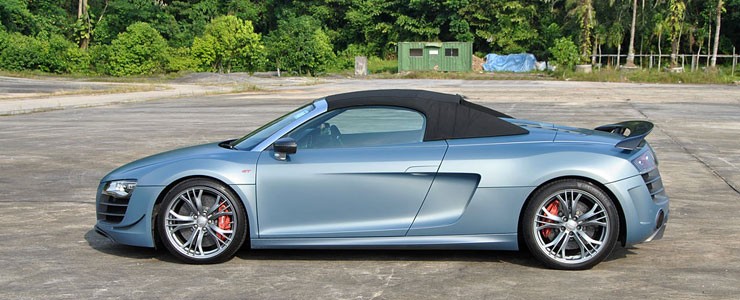 |
Like on mid-engine Spider models like the Gallardo and Ferrari 430, the R8 Spyder’s fabric roof features flying buttresses at the rear to give the Spyder an elegant profile when the roof is closed while the rear heated glass window can be lowered separately when the roof is in place and acts as a wind stop when raised.
Audi claims that the whole roof set-up weighs in at just 42kg, which makes the Spyder not too significantly heavier than the coupe. The roof retracts gracefully to fold away and stow itself into a compartment above the engine just behind the seats in just 19 seconds with the pull of a switch on the centre console.
Just like the other topless convertible Audi models like the A5 Cabriolet and TT Roadster, the R8GT Spyder’s roof can be operated at speeds of up to 50km/h.
Interior
Inside, the R8 Spyder’s cabin has been spruced up with sporty bits to keep up with the GT’s overall sportier character. There is widespread use of grippy, anti-reflective Alcantara on the A-pillars, seats, steering wheel, hand brake lever and so on while those single piece racing buckets not only look good but also contribute to substantial weight savings.
Other GT specific bits include the white faced instruments, contrasting red stitching on the seats and steering wheel, carbon fibre dash and door inserts as well as the bespoke GT gear lever with the knob bearing the limited edition number of the car.
Audi claims that the whole roof set-up weighs in at just 42kg, which makes the Spyder not too significantly heavier than the coupe. The roof retracts gracefully to fold away and stow itself into a compartment above the engine just behind the seats in just 19 seconds with the pull of a switch on the centre console.
Just like the other topless convertible Audi models like the A5 Cabriolet and TT Roadster, the R8GT Spyder’s roof can be operated at speeds of up to 50km/h.
Interior
Inside, the R8 Spyder’s cabin has been spruced up with sporty bits to keep up with the GT’s overall sportier character. There is widespread use of grippy, anti-reflective Alcantara on the A-pillars, seats, steering wheel, hand brake lever and so on while those single piece racing buckets not only look good but also contribute to substantial weight savings.
Other GT specific bits include the white faced instruments, contrasting red stitching on the seats and steering wheel, carbon fibre dash and door inserts as well as the bespoke GT gear lever with the knob bearing the limited edition number of the car.
Weighing in at 1640kg, the GT is some 85kg lighter than the V10 Spyder it is based on. This weight saving, together with the additional 35kg squeezed out of the 5.2-litre V10, means that the GT is noticeably more accelerative off the line and stronger at higher revs. On paper, the 560bhp and 540Nm GT Spyder will take just 3.8 seconds for the 0-100km/h sprint, a reduction of 0.3 seconds over the standard V10 Spyder. When it comes to top speed, the GT’s 317km/h is a 4km/h improvement over the V10.
The V10 thrives on revs even though it is flexible enough at low speeds. It feels relatively sedated below 4000rpm or when the exhaust valves remain close. Once the tacho needle goes past 6000rpm though, a big wave of power sets in and it lasts all the way to its 8700rpm cut out. The V10’s 560 horses are more than enough to scare your passenger with its brutal acceleration forces.
A supercar isn’t one unless it makes the right noises. The R8’s V10 makes a typical V10 roar that is often associated with Lamborghini Gallardos and Dodge Vipers. Moreover with the topless Spyder, one can enjoy the intoxicating V10 soundtrack at maximum revs without a roof getting in the way.
The V10 thrives on revs even though it is flexible enough at low speeds. It feels relatively sedated below 4000rpm or when the exhaust valves remain close. Once the tacho needle goes past 6000rpm though, a big wave of power sets in and it lasts all the way to its 8700rpm cut out. The V10’s 560 horses are more than enough to scare your passenger with its brutal acceleration forces.
A supercar isn’t one unless it makes the right noises. The R8’s V10 makes a typical V10 roar that is often associated with Lamborghini Gallardos and Dodge Vipers. Moreover with the topless Spyder, one can enjoy the intoxicating V10 soundtrack at maximum revs without a roof getting in the way.
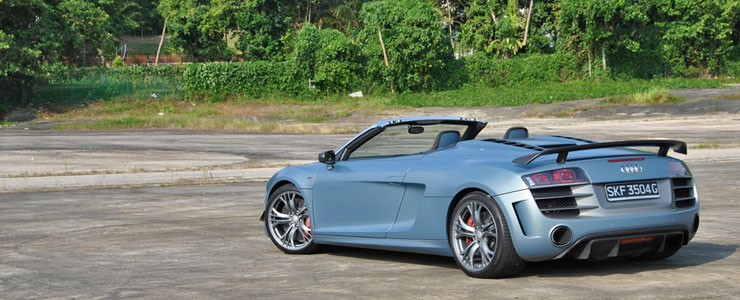 |
Unlike the standard car where there’s a choice between a six-speed manual gearbox and the R-tronic automated manual, only the latter is available in the GT. The GT’s R-tronic is a marked improvement over earlier versions that we’ve tried on R8 models but its single clutch design means it’ll never be as smooth or as quick a dual clutch S-tronic box.
Gear changes that come with mistimed throttle inputs will result in a noticeable jerk and jolt that can be rather uncomfortable to some. In auto mode, the box can also suffer from delayed up and down changes which make its gear swapping highly intuitive when compared to a more modern twin clutch design. Audi though, will address this shortcoming of the R8 models with a new seven-speed S-tronic gearbox in the upcoming updated model.
To match the GT’s extra performance and hardcore character, the standard R8 Spyder’s suspension has been beefed up. The ride height has been lowered by 10mm while recalibrated dampers and springs have further improved body control overall. For the GT Spyder to strut its dynamic prowess, you’d have to paddle it on a fast and twisty bit of tarmac like a racetrack or a B-road. This is where the GT Spyder will show off its handling agility and sporting nature. The Spyder always feels eager to swap directions and responds quickly to steering inputs despite having its top chopped off.
Like all powerful and sporty Audis, quattro all-wheel drive is a standard feature. The R8’s quattro is a highly rear biased system which means that it behaves more like a rear-wheel drive car than one with four driven wheels. Floor the accelerator out of a bend with the ESP fully turned off (there’s a Sport mode as well that suits us really fine) and the R8 will easily snap into oversteer when the grip on the rear wheels is overcome by the engine’s grunt.
Gear changes that come with mistimed throttle inputs will result in a noticeable jerk and jolt that can be rather uncomfortable to some. In auto mode, the box can also suffer from delayed up and down changes which make its gear swapping highly intuitive when compared to a more modern twin clutch design. Audi though, will address this shortcoming of the R8 models with a new seven-speed S-tronic gearbox in the upcoming updated model.
To match the GT’s extra performance and hardcore character, the standard R8 Spyder’s suspension has been beefed up. The ride height has been lowered by 10mm while recalibrated dampers and springs have further improved body control overall. For the GT Spyder to strut its dynamic prowess, you’d have to paddle it on a fast and twisty bit of tarmac like a racetrack or a B-road. This is where the GT Spyder will show off its handling agility and sporting nature. The Spyder always feels eager to swap directions and responds quickly to steering inputs despite having its top chopped off.
Like all powerful and sporty Audis, quattro all-wheel drive is a standard feature. The R8’s quattro is a highly rear biased system which means that it behaves more like a rear-wheel drive car than one with four driven wheels. Floor the accelerator out of a bend with the ESP fully turned off (there’s a Sport mode as well that suits us really fine) and the R8 will easily snap into oversteer when the grip on the rear wheels is overcome by the engine’s grunt.
The GT’s standard carbon ceramic brakes not only offer strong and consistent stopping power, the left pedal is a breeze to modulate braking power with.
Conclusion
Exclusivity usually comes at a price and it’s no different for the limited production run R8 GT Spyder. For close to a million dollars though, you do get more performance, improved looks and handling than the standard R8 Spyder. On the downside, its high price tag also means that the GT Spyder’s sticker price is well within reach of even more exotic models from Ferrari, McLaren and Lamborghini.
Conclusion
Exclusivity usually comes at a price and it’s no different for the limited production run R8 GT Spyder. For close to a million dollars though, you do get more performance, improved looks and handling than the standard R8 Spyder. On the downside, its high price tag also means that the GT Spyder’s sticker price is well within reach of even more exotic models from Ferrari, McLaren and Lamborghini.
When the R8 LMS GT3 race car was first unveiled way back in 2009, rumours were abuzz that Audi will introduce a hardcore, lighter version of the R8 V10 in time to come. This model finally became a reality last year with the debut of the 560bhp LMS-inspired R8 GT.
With a limited production run of just 333 cars, it wasn't long before the GT was sold out. Don’t fret though - those that have missed the GT coupe will be glad to know that Audi has introduced a drop-top Spyder version of the GT, the GT Spyder. Just like the GT coupe, the GT Spyder will also be a limited production model with a 333 production run for all worldwide markets, will only three examples for the Singapore market.
Exterior
On the outside, the GT can instantly be recognised by its carbon fibre finished go faster bits that include canards on the sides of the front bumper, front lower lip, air vents on the rear deck, fixed rear spoiler, large rear diffuser all made from lightweight CFRP carbon fibre composites.
Other notable styling features include the titanium coloured finish on the front grille inserts, air inlet horizontal fins, rear valance and 19-inch double spoke Y-design alloy wheels as well as large diameter exhaust tips and additional vented slots on the rear bumper.
The GT is also available in a variety of bespoke exterior shades that aren’t available on the other models that include matt finishes like the car pictured here. The carbon bits and the GT’s 10mm lowered suspension do give the range topping R8 Spyder an even sportier outlook than the standard car.
With a limited production run of just 333 cars, it wasn't long before the GT was sold out. Don’t fret though - those that have missed the GT coupe will be glad to know that Audi has introduced a drop-top Spyder version of the GT, the GT Spyder. Just like the GT coupe, the GT Spyder will also be a limited production model with a 333 production run for all worldwide markets, will only three examples for the Singapore market.
Exterior
On the outside, the GT can instantly be recognised by its carbon fibre finished go faster bits that include canards on the sides of the front bumper, front lower lip, air vents on the rear deck, fixed rear spoiler, large rear diffuser all made from lightweight CFRP carbon fibre composites.
Other notable styling features include the titanium coloured finish on the front grille inserts, air inlet horizontal fins, rear valance and 19-inch double spoke Y-design alloy wheels as well as large diameter exhaust tips and additional vented slots on the rear bumper.
The GT is also available in a variety of bespoke exterior shades that aren’t available on the other models that include matt finishes like the car pictured here. The carbon bits and the GT’s 10mm lowered suspension do give the range topping R8 Spyder an even sportier outlook than the standard car.
Everything else on the GT Spyder's exterior is similar to the V10 Spyder's, including the lack of the coupe's characteristic side blade styling feature and see through glass engine cover. The latter is replaced by dramatic looking louvres for cooling the engine.
Like on mid-engine Spider models like the Gallardo and Ferrari 430, the R8 Spyder’s fabric roof features flying buttresses at the rear to give the Spyder an elegant profile when the roof is closed while the rear heated glass window can be lowered separately when the roof is in place and acts as a wind stop when raised.
Audi claims that the whole roof set-up weighs in at just 42kg, which makes the Spyder not too significantly heavier than the coupe. The roof retracts gracefully to fold away and stow itself into a compartment above the engine just behind the seats in just 19 seconds with the pull of a switch on the centre console.
Just like the other topless convertible Audi models like the A5 Cabriolet and TT Roadster, the R8GT Spyder’s roof can be operated at speeds of up to 50km/h.
Interior
Inside, the R8 Spyder’s cabin has been spruced up with sporty bits to keep up with the GT’s overall sportier character. There is widespread use of grippy, anti-reflective Alcantara on the A-pillars, seats, steering wheel, hand brake lever and so on while those single piece racing buckets not only look good but also contribute to substantial weight savings.
Other GT specific bits include the white faced instruments, contrasting red stitching on the seats and steering wheel, carbon fibre dash and door inserts as well as the bespoke GT gear lever with the knob bearing the limited edition number of the car.
Audi claims that the whole roof set-up weighs in at just 42kg, which makes the Spyder not too significantly heavier than the coupe. The roof retracts gracefully to fold away and stow itself into a compartment above the engine just behind the seats in just 19 seconds with the pull of a switch on the centre console.
Just like the other topless convertible Audi models like the A5 Cabriolet and TT Roadster, the R8GT Spyder’s roof can be operated at speeds of up to 50km/h.
Interior
Inside, the R8 Spyder’s cabin has been spruced up with sporty bits to keep up with the GT’s overall sportier character. There is widespread use of grippy, anti-reflective Alcantara on the A-pillars, seats, steering wheel, hand brake lever and so on while those single piece racing buckets not only look good but also contribute to substantial weight savings.
Other GT specific bits include the white faced instruments, contrasting red stitching on the seats and steering wheel, carbon fibre dash and door inserts as well as the bespoke GT gear lever with the knob bearing the limited edition number of the car.
Weighing in at 1640kg, the GT is some 85kg lighter than the V10 Spyder it is based on. This weight saving, together with the additional 35kg squeezed out of the 5.2-litre V10, means that the GT is noticeably more accelerative off the line and stronger at higher revs. On paper, the 560bhp and 540Nm GT Spyder will take just 3.8 seconds for the 0-100km/h sprint, a reduction of 0.3 seconds over the standard V10 Spyder. When it comes to top speed, the GT’s 317km/h is a 4km/h improvement over the V10.
The V10 thrives on revs even though it is flexible enough at low speeds. It feels relatively sedated below 4000rpm or when the exhaust valves remain close. Once the tacho needle goes past 6000rpm though, a big wave of power sets in and it lasts all the way to its 8700rpm cut out. The V10’s 560 horses are more than enough to scare your passenger with its brutal acceleration forces.
A supercar isn’t one unless it makes the right noises. The R8’s V10 makes a typical V10 roar that is often associated with Lamborghini Gallardos and Dodge Vipers. Moreover with the topless Spyder, one can enjoy the intoxicating V10 soundtrack at maximum revs without a roof getting in the way.
The V10 thrives on revs even though it is flexible enough at low speeds. It feels relatively sedated below 4000rpm or when the exhaust valves remain close. Once the tacho needle goes past 6000rpm though, a big wave of power sets in and it lasts all the way to its 8700rpm cut out. The V10’s 560 horses are more than enough to scare your passenger with its brutal acceleration forces.
A supercar isn’t one unless it makes the right noises. The R8’s V10 makes a typical V10 roar that is often associated with Lamborghini Gallardos and Dodge Vipers. Moreover with the topless Spyder, one can enjoy the intoxicating V10 soundtrack at maximum revs without a roof getting in the way.
Unlike the standard car where there’s a choice between a six-speed manual gearbox and the R-tronic automated manual, only the latter is available in the GT. The GT’s R-tronic is a marked improvement over earlier versions that we’ve tried on R8 models but its single clutch design means it’ll never be as smooth or as quick a dual clutch S-tronic box.
Gear changes that come with mistimed throttle inputs will result in a noticeable jerk and jolt that can be rather uncomfortable to some. In auto mode, the box can also suffer from delayed up and down changes which make its gear swapping highly intuitive when compared to a more modern twin clutch design. Audi though, will address this shortcoming of the R8 models with a new seven-speed S-tronic gearbox in the upcoming updated model.
To match the GT’s extra performance and hardcore character, the standard R8 Spyder’s suspension has been beefed up. The ride height has been lowered by 10mm while recalibrated dampers and springs have further improved body control overall. For the GT Spyder to strut its dynamic prowess, you’d have to paddle it on a fast and twisty bit of tarmac like a racetrack or a B-road. This is where the GT Spyder will show off its handling agility and sporting nature. The Spyder always feels eager to swap directions and responds quickly to steering inputs despite having its top chopped off.
Like all powerful and sporty Audis, quattro all-wheel drive is a standard feature. The R8’s quattro is a highly rear biased system which means that it behaves more like a rear-wheel drive car than one with four driven wheels. Floor the accelerator out of a bend with the ESP fully turned off (there’s a Sport mode as well that suits us really fine) and the R8 will easily snap into oversteer when the grip on the rear wheels is overcome by the engine’s grunt.
Gear changes that come with mistimed throttle inputs will result in a noticeable jerk and jolt that can be rather uncomfortable to some. In auto mode, the box can also suffer from delayed up and down changes which make its gear swapping highly intuitive when compared to a more modern twin clutch design. Audi though, will address this shortcoming of the R8 models with a new seven-speed S-tronic gearbox in the upcoming updated model.
To match the GT’s extra performance and hardcore character, the standard R8 Spyder’s suspension has been beefed up. The ride height has been lowered by 10mm while recalibrated dampers and springs have further improved body control overall. For the GT Spyder to strut its dynamic prowess, you’d have to paddle it on a fast and twisty bit of tarmac like a racetrack or a B-road. This is where the GT Spyder will show off its handling agility and sporting nature. The Spyder always feels eager to swap directions and responds quickly to steering inputs despite having its top chopped off.
Like all powerful and sporty Audis, quattro all-wheel drive is a standard feature. The R8’s quattro is a highly rear biased system which means that it behaves more like a rear-wheel drive car than one with four driven wheels. Floor the accelerator out of a bend with the ESP fully turned off (there’s a Sport mode as well that suits us really fine) and the R8 will easily snap into oversteer when the grip on the rear wheels is overcome by the engine’s grunt.
The GT’s standard carbon ceramic brakes not only offer strong and consistent stopping power, the left pedal is a breeze to modulate braking power with.
Conclusion
Exclusivity usually comes at a price and it’s no different for the limited production run R8 GT Spyder. For close to a million dollars though, you do get more performance, improved looks and handling than the standard R8 Spyder. On the downside, its high price tag also means that the GT Spyder’s sticker price is well within reach of even more exotic models from Ferrari, McLaren and Lamborghini.
Conclusion
Exclusivity usually comes at a price and it’s no different for the limited production run R8 GT Spyder. For close to a million dollars though, you do get more performance, improved looks and handling than the standard R8 Spyder. On the downside, its high price tag also means that the GT Spyder’s sticker price is well within reach of even more exotic models from Ferrari, McLaren and Lamborghini.
Car Information
Audi R8 GT Spyder 5.2 FSI qu R tronic (A)
CAT B|Petrol|7.1km/L
Horsepower
418kW (560 bhp)
Torque
540 Nm
Acceleration
3.8sec (0-100km /hr)
This model is no longer being sold by local distributor
All Used Audi R8 GT SpyderThank You For Your Subscription.























